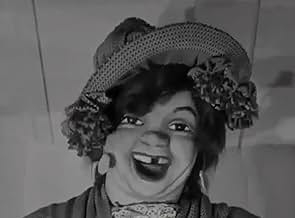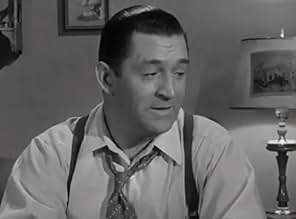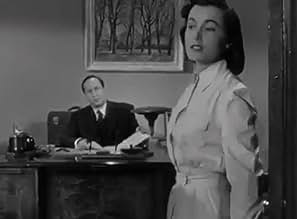अपनी भाषा में प्लॉट जोड़ेंMany interested parties are after the loot from a factory payroll heist but the mobster who hid it has amnesia after undergoing experimental brain surgery in the prison hospital.Many interested parties are after the loot from a factory payroll heist but the mobster who hid it has amnesia after undergoing experimental brain surgery in the prison hospital.Many interested parties are after the loot from a factory payroll heist but the mobster who hid it has amnesia after undergoing experimental brain surgery in the prison hospital.
Chris Alcaide
- Pursuing Detective
- (बिना क्रेडिट के)
Fred Aldrich
- Cop
- (बिना क्रेडिट के)
Leonard Bremen
- Guard at Clinic
- (बिना क्रेडिट के)
Paul Bryar
- Freddie - Bartender
- (बिना क्रेडिट के)
Sayre Dearing
- Patient in Wheelchair at Clinic
- (बिना क्रेडिट के)
Frank Fenton
- Detective Driver
- (बिना क्रेडिट के)
John Harmon
- Herman
- (बिना क्रेडिट के)
Mary Alan Hokanson
- Nurse
- (बिना क्रेडिट के)
Shepard Menken
- Interne
- (बिना क्रेडिट के)
Howard Negley
- Detective
- (बिना क्रेडिट के)
Frank O'Connor
- Gate Guard
- (बिना क्रेडिट के)
फ़ीचर्ड समीक्षाएं
Originally made in 3-D, this is another of Columbia's black & white releases of this genre (like Vincent Price in the Mad Magician). 3-D process and numerous subjective camera techniques (like scapels used in operation coming out at the screen, bullets firing at speeding cars, whirling around car rides at an amusement park, etc.)make this interesting viewing and out of the ordinary story about a thug who can't remember anything about his $130,000 heist after brain surgery.
After reading some negative reviews of this film, I expected it to be a pretty stale B-movie about gangsters and stolen dough. However, I found this to be a pretty entertaining B-movie with some humorous 3-D effects, and some wonderful footage of an amusement park circa 1953.
The script for this film, is indeed pretty routine with the typical gangster stereotypes seen in most films of the period. Edmund O'Brien gives a very good performance, however. There are also a few other familiar character actors in the film, which make for interesting viewing.
The 3-D gimmicks utilized throughout (scalpels, cigars, guns, a flower pot, roller coaster) are fun to spot, and good for a laugh. The greatest asset this film has though, is it's use of location filming. There is an interesting chase across some rooftops which works very well, but best of all are the amusement park scenes, including a roller coaster ride, and some really nice close-ups of the Fun House Laughing Sal figure. If for no other reason, see the film for her presence.
The script for this film, is indeed pretty routine with the typical gangster stereotypes seen in most films of the period. Edmund O'Brien gives a very good performance, however. There are also a few other familiar character actors in the film, which make for interesting viewing.
The 3-D gimmicks utilized throughout (scalpels, cigars, guns, a flower pot, roller coaster) are fun to spot, and good for a laugh. The greatest asset this film has though, is it's use of location filming. There is an interesting chase across some rooftops which works very well, but best of all are the amusement park scenes, including a roller coaster ride, and some really nice close-ups of the Fun House Laughing Sal figure. If for no other reason, see the film for her presence.
Edmond O'Brien plays a criminal who is paroled to participate in experimental brain surgery which will remove his criminal impulses as well as his memory. The problem is that his former partners want their shares of $130,000 he stole before he went to jail. (Big Plot problem: Why would O'Brien agree to participate in this experiment if he knew he had a bundle waiting for him? Wouldn't he just do his time?) This B-crime drama, too light in tone to qualify as a Film-noir (check out O'Brien in DOA if you want to see some real Film Noir), with its paper-thin characterizations and dated tough guy dialog, would be easily forgotten if not for its status as the first Big Studio picture released in 3-D. Check it out: It beat "House of Wax" to the screens by one day. I just had the good fortune to see an excellent print of the film today at the Maryland Film Festival. (I should say prints, since it was projected by two cameras simultaneously.) The 3-D experience more than compensated for any deficiencies in the script. (In the film's defense, it does move along quite quickly in its effort to entertain.) I have seen many of the classic 3-D films in their natural format, and I found the 3-D in this film fabulous. Just seeing the black & white Columbia logo itself was worth the price of admission. Oddly, however, the intentional 3-D effects, amusing as they could sometimes be, distracted from the overall 3-D experience. I found myself fascinated simply by the illusion of depth in simple conversational scenes with the occasional object in the foreground. If I were flipping through the channels and watched a bit of this film flat on television, I doubt I would linger very long on it, but the excellent 3-D made it a worthwhile theatrical experience. Check it out if you ever get the chance.
Edmond O'Brien stars in "Man in the Dark," a 1953 film also starring Audrey Totter. O'Brien plays Steve Rawley, a prisoner who undergoes experimental surgery that's supposed to erase the criminal elements of his brain. It also wipes his memory of past events.
Unfortunately Steve and some other thugs committed a big robbery and Steve hid the money. Now that he has no memory, he doesn't know where he put it. His old gang kidnaps him and tries to find out his hiding place. His old girlfriend Peg (Totter) is around, and she wants him to forget the whole thing and go away with her.
Steve starts remembering things in the form of bizarre dreams. He and Peg attempt to follow the clues in the dreams to track down the money.
Edmond O'Brien made a lot of these B films for Columbia. This one is no better or worse than many of them. The last part of the film takes place in an amusement park, and it's very good.
Originally this film was in 3-D, and like some other films, it was filmed in the seen-better-days area of Ocean Park near Venice, CA. I always like seeing the old LA, and this film has lots of shots of it.
I had one major problem with this film, and it's a major plot hole. If you had stolen a lot of money and hidden it, why would you agree to a surgery that is going to clean out your memory so that you don't remember where you hid it?
I don't know the answer.
Unfortunately Steve and some other thugs committed a big robbery and Steve hid the money. Now that he has no memory, he doesn't know where he put it. His old gang kidnaps him and tries to find out his hiding place. His old girlfriend Peg (Totter) is around, and she wants him to forget the whole thing and go away with her.
Steve starts remembering things in the form of bizarre dreams. He and Peg attempt to follow the clues in the dreams to track down the money.
Edmond O'Brien made a lot of these B films for Columbia. This one is no better or worse than many of them. The last part of the film takes place in an amusement park, and it's very good.
Originally this film was in 3-D, and like some other films, it was filmed in the seen-better-days area of Ocean Park near Venice, CA. I always like seeing the old LA, and this film has lots of shots of it.
I had one major problem with this film, and it's a major plot hole. If you had stolen a lot of money and hidden it, why would you agree to a surgery that is going to clean out your memory so that you don't remember where you hid it?
I don't know the answer.
I watched most of Man in the Dark without realising it was originally shot in 3D. At first I thought I was watching a lost Fritz Lang classic---extreme closeups, odd points of view, shattering glass---until I remembered the film had been directed by, ahem, Lew Landers. Now nothing against old Lew, he delivered many a fine B picture, but Man in the Dark doesn't look like your typical Columbia programmer. It's black and white take on the 3D process is more noir than you'd expect and it obviously helped to have Floyd Crosby behind the camera. Edmond O'Brien and Audrey Totter are good as always, overcoming a pretty hackneyed script that is the film's major shortcoming. Worth seeing for the dream sequence alone, where O'Brien is pursued by policemen in bumper cars!!
क्या आपको पता है
- ट्रिवियाThe first 3-D feature ever released by a major American studio. House of Wax (1953) went into production first, but Columbia rushed "Man in the Dark" - shooting it in a mere 11 days - to get it into theaters just days before "Wax" opened. (Bwana Devil (1952) preceded both of them, but United Artists was not considered a major studio in the early 1950s.)
- गूफ़During the chase when Steve is abducted, one of the crooks leans out of the car and fires nine shots at the cops from a six-shot revolver.
- भाव
[first lines]
Cop: You get prettier every day.
Nurse Receptionist: Tell me about the beauty contest you won.
- इसके अलावा अन्य वर्जनOriginally released in 3D, in prints that were sepia-toned.
- कनेक्शनFeatured in TJ and the All Night Theatre: The Man Who Lived Twice (1979)
टॉप पसंद
रेटिंग देने के लिए साइन-इन करें और वैयक्तिकृत सुझावों के लिए वॉचलिस्ट करें
विवरण
- चलने की अवधि1 घंटा 10 मिनट
- पक्ष अनुपात
- 1.37 : 1
इस पेज में योगदान दें
किसी बदलाव का सुझाव दें या अनुपलब्ध कॉन्टेंट जोड़ें




































